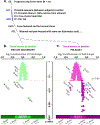Gene expression profiling reveals a lingering effect of prenatal alcohol exposure on inflammatory-related genes during adolescence and adulthood
- PMID: 32505093
- PMCID: PMC7387206
- DOI: 10.1016/j.cyto.2020.155126
Gene expression profiling reveals a lingering effect of prenatal alcohol exposure on inflammatory-related genes during adolescence and adulthood
Abstract
Prenatal Alcohol Exposure (PAE) exerts devastating effects on the Central Nervous System (CNS), which vary as a function of both ethanol load and gestational age of exposure. A growing body of evidence suggests that alcohol exposure profoundly impacts a wide range of cytokines and other inflammation-related genes in the CNS. The olfactory system serves as a critical interface between infectious/inflammatory signals and other aspects of CNS function, and demonstrates long-lasting plasticity in response to alcohol exposure. We therefore utilized transcriptome profiling to identify gene expression patterns for immune-related gene families in the olfactory bulb of Long Evans rats. Pregnant dams received either an ad libitum liquid diet containing 35% daily calories from ethanol (ET), a pair-fed diet (PF) matched for caloric content, or free choice (FCL) access to the liquid diet and water from Gestational Day (GD) 11-20. Offspring were fostered to dams fed the FCL diet, weaned on P21, and then housed with same-sex littermates until mid-adolescence (P40) or young adulthood (P90). At the target ages of P40 or P90, offspring were euthanized via brief CO2 exposure and brains/blood were collected. Gene expression analysis was performed using a Rat Gene 1.0 ST Array (Affymetrix), and preliminary analyses focused on two moderately overlapping gene clusters, including all immune-related genes and those related to neuroinflammation. A total of 146 genes were significantly affected by prenatal Diet condition, whereas the factor of Age (P40 vs P90) revealed 998 genes significantly changed, and the interaction between Diet and Age yielded 162 significant genes. From this dataset, we applied a threshold of 1.3-fold change (30% increase or decrease in expression) for inclusion in later analyses. Findings indicated that in adolescents, few genes were altered by PAE, whereas adults displayed an increase of a wide range of gene upregulation as a result of PAE. Pathway analysis predicted an increase in Nf-κB activation in adolescence and a decrease in adulthood due to prenatal ethanol exposure, indicating age-specific and long-lasting alterations to immune signaling. These data may provide important insight into the relationship between immune-related signaling cascades and long-term changes in olfactory bulb function after PAE.
Keywords: Cytokine; Ethanol; Neuroimmune; Olfactory bulb; Prenatal.
Copyright © 2020 Elsevier Ltd. All rights reserved.
Conflict of interest statement
Declaration of Competing Interest The authors declare that they have no known competing financial interests or personal relationships that could have appeared to influence the work reported in this paper.
Figures





Similar articles
-
Prenatal alcohol exposure alters expression of genes involved in cell adhesion, immune response, and toxin metabolism in adolescent rat hippocampus.PLoS One. 2024 Jan 25;19(1):e0293425. doi: 10.1371/journal.pone.0293425. eCollection 2024. PLoS One. 2024. PMID: 38271377 Free PMC article.
-
Lingering Effects of Prenatal Alcohol Exposure on Basal and Ethanol-Evoked Expression of Inflammatory-Related Genes in the CNS of Adolescent and Adult Rats.Front Behav Neurosci. 2020 Jun 29;14:82. doi: 10.3389/fnbeh.2020.00082. eCollection 2020. Front Behav Neurosci. 2020. PMID: 32714160 Free PMC article.
-
Prenatal alcohol exposure alters steady-state and activated gene expression in the adult rat brain.Alcohol Clin Exp Res. 2015 Feb;39(2):251-61. doi: 10.1111/acer.12622. Alcohol Clin Exp Res. 2015. PMID: 25684047 Free PMC article.
-
Prenatal and adolescent alcohol exposure programs immunity across the lifespan: CNS-mediated regulation.Pharmacol Biochem Behav. 2022 May;216:173390. doi: 10.1016/j.pbb.2022.173390. Epub 2022 Apr 18. Pharmacol Biochem Behav. 2022. PMID: 35447157 Free PMC article. Review.
-
Effects of prenatal alcohol exposure on the olfactory system development.Front Neural Circuits. 2024 May 15;18:1408187. doi: 10.3389/fncir.2024.1408187. eCollection 2024. Front Neural Circuits. 2024. PMID: 38818309 Free PMC article. Review.
Cited by
-
Ontogenetic Neuroimmune Changes Following Prenatal Alcohol Exposure: Implications for Neurobehavioral Function.Adv Exp Med Biol. 2025;1473:15-39. doi: 10.1007/978-3-031-81908-7_2. Adv Exp Med Biol. 2025. PMID: 40128473 Review.
-
Choline Supplementation Alters Hippocampal Cytokine Levels in Adolescence and Adulthood in an Animal Model of Fetal Alcohol Spectrum Disorders.Cells. 2023 Feb 8;12(4):546. doi: 10.3390/cells12040546. Cells. 2023. PMID: 36831213 Free PMC article.
-
Choline Supplementation Modifies the Effects of Developmental Alcohol Exposure on Immune Responses in Adult Rats.Nutrients. 2022 Jul 13;14(14):2868. doi: 10.3390/nu14142868. Nutrients. 2022. PMID: 35889826 Free PMC article.
-
Intersection of Epigenetic and Immune Alterations: Implications for Fetal Alcohol Spectrum Disorder and Mental Health.Front Neurosci. 2021 Dec 3;15:788630. doi: 10.3389/fnins.2021.788630. eCollection 2021. Front Neurosci. 2021. PMID: 34924946 Free PMC article. Review.
-
Prenatal alcohol exposure alters expression of genes involved in cell adhesion, immune response, and toxin metabolism in adolescent rat hippocampus.PLoS One. 2024 Jan 25;19(1):e0293425. doi: 10.1371/journal.pone.0293425. eCollection 2024. PLoS One. 2024. PMID: 38271377 Free PMC article.
References
-
- CDC. Fetal Alcohol Spectrum Disorders (FASDs): Data & Statistics. 2017. March 27, 2017 [cited 2017 6/1/2017]; Available from: https://www.cdc.gov/ncbddd/fasd/data.html.
-
- Schambra UB, Lewis CN, and Harrison TA, Deficits in spatial learning and memory in adult mice following acute, low or moderate levels of prenatal ethanol exposure during gastrulation or neurulation. Neurotoxicology and Teratology, 2017. - PubMed
Publication types
MeSH terms
Substances
Grants and funding
LinkOut - more resources
Full Text Sources

